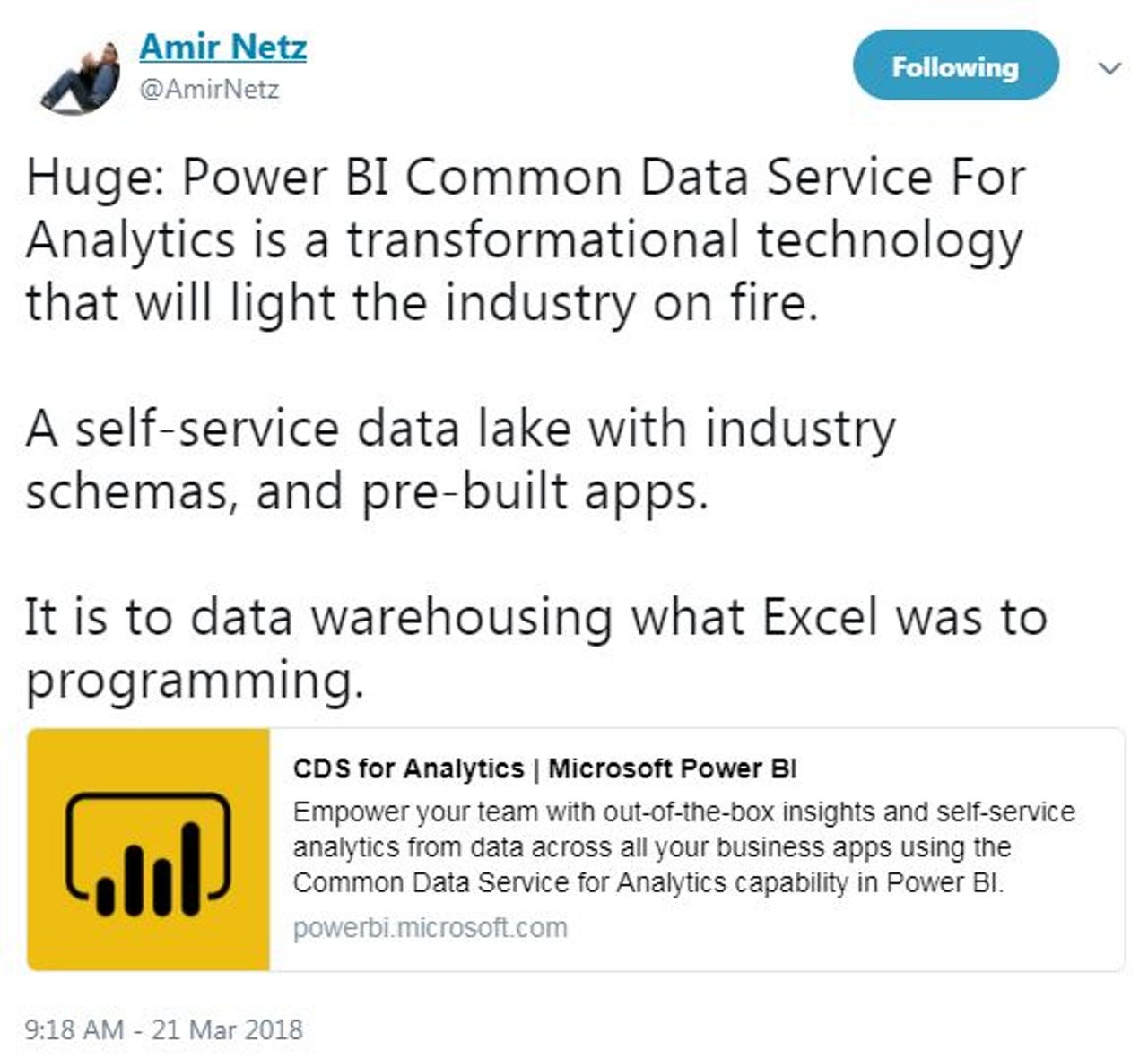Making sense of Microsoft's Common Data Service makeover

Some of the most interesting pieces of Microsoft's Dynamics 365 'Spring '18' wave of updates are the under-the-covers services aimed at developers and business analysts.

The new Common Data Service for Apps and Common Data Service for Analytics ---both set to debut some time in the second quarter of the year -- are what's got not just some Microsoft partners and customers, but also Microsoft execs themselves, excited.
Microsoft CEO Satya Nadella, in a demo video posted to LinkedIn this week, described the new PowerApps-related CDS capabilities introduced this week as providing developers with something "kind of like PowerPoint for building apps." And Microsoft Technical Fellow and Chief Technology Officer of Power BI and Intelligence Platform Amir Netz tweeted that the Common Data Service for Analytics is as being "to data warehousing what Excel was to programming."
When Microsoft first launched Dynamics 365 in 2016, Microsoft officials talked about its new CRM/ERP platform being built on the Common Data Model (CDM). The CDM is a business database for storing and managing business entities. Subsequently, Microsoft execs starting using "Common Data Service," rather than CDM to explain the underlying guts of Dynamics 365.
Microsoft's original definition of CDS:
"The Common Data Service is the Microsoft Azure-based business application platform that enables you to easily build and extend applications with their business data. The Common Data Service does the heavy lifting of bringing together your data from across the Dynamics 365 family of services so you can focus on building and delivering the apps, insights and process automation that matter to you and your customers with PowerApps, Power BI, and Microsoft Flow."
The new Common Data Service for Apps and Common Data Service for Analytics are not built on top of the original CDS, as Microsoft's own documentation makes clear, calling the current CDS the "previous version."
Instead, the new Common Data Service for Apps seems to be XRM revisited. Microsoft Business Solutions MVP Jukka Niiranen (who also is the Dynamics 365 Technical Lead at Finnish telco/cloud company Elisa) blogged this week that "XRM = CDS v2."
XRM was Microsoft's original "anything relationship management" platform that developers used to write line-of-business apps built on top of the stack originally powering Microsoft's CRM. Then XRM became an Azure-based platform that wasn't just limited to sales.
While the original Common Data Service platform had theoretical appeal, many found it not very useful in practice, as Niiranen blogged. That's what's behind going with XRM as the platform to try to make PowerApps more useful by enterprise developers, he argued.
In typical Microsoft branding fashion, the new Common Data Service for Analytics platform doesn't seem to have much to do with the Common Data Service for Apps platform -- beyond the name. I'm guessing Microsoft is using the same branding because PowerApps, Flow (its IFTTT service), Power BI and the Common Data Service are all part of the Microsoft Business Application Platform.
The idea behind Common Data Service for Analytics is to more tightly link Dynamics 365 and Power BI. As Nadella outlined the vision in the aforementioned video: "Every app becomes, esentially, an analytics probe," enabling users to have data coming back to them from Dynamics 365, Salesforce (and one day, other third-party CRM/ERP apps and services) that they can more easily visualize in Power BI.
The Common Data Service for Analytics is being touted as a coming feature of Power BI and is built on the Common Data Model, according to company blog posts. (So maybe it's the use of the CDM by both of the Common Data Services that is the missing link?) Previews of the first Power BI Insights apps using the technology are coming for Sales and Service in the second quarter, as well.
The "Common Data Service for Analytics expands Power BI to provide a self-service data lake of business entities stored and manipulated directly within the Power BI Service," says Microsoft in its 200-plus page PDF of the Release Notes for the coming Spring '18 update.
That's my best first attempt at trying to explain these new capabilities. Comments, critiques and more content links are all welcome.